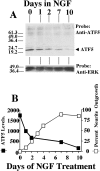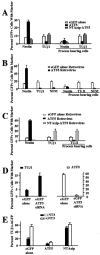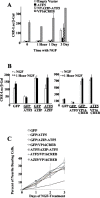Regulated expression of ATF5 is required for the progression of neural progenitor cells to neurons
- PMID: 12805299
- PMCID: PMC6740805
- DOI: 10.1523/JNEUROSCI.23-11-04590.2003
Regulated expression of ATF5 is required for the progression of neural progenitor cells to neurons
Abstract
An important milestone in brain development is the transition of neuroprogenitor cells to postmitotic neurons. We report that the bZIP transcription factor ATF5 plays a major regulatory role in this process. In developing brain ATF5 expression is high within ventricular zones containing neural stem and progenitor cells and is undetectable in postmitotic neurons. In attached clonal neurosphere cultures ATF5 is expressed by neural stem/progenitor cells and is undetectable in tau-positive neurons. In PC12 cell cultures nerve growth factor (NGF) dramatically downregulates endogenous ATF5 protein and transcripts, whereas exogenous ATF5 suppresses NGF-promoted neurite outgrowth. Such inhibition requires the repression of CRE sites. In contrast, loss of function conferred by dominant-negative ATF5 accelerates NGF-promoted neuritogenesis. Exogenous ATF5 also suppresses, and dominant-negative ATF5 and a small-interfering RNA targeted to ATF5 promote, neurogenesis by cultured nestin-positive telencephalic cells. These findings indicate that ATF5 blocks the differentiation of neuroprogenitor cells into neurons and must be downregulated to permit this process to occur.
Figures







References
-
- Angelastro JM, Moon NY, Liu DX, Yang AS, Greene LA, Franke TF ( 2001) Characterization of a novel isoform of caspase-9 that inhibits apoptosis. J Biol Chem 276: 12190–12200. - PubMed
-
- Barco A, Alarcon JM, Kandel ER ( 2002) Expression of constitutively active CREB protein facilitates the late phase of long-term potentiation by enhancing synaptic capture. Cell 108: 689–703. - PubMed
-
- Bhatia M ( 2001) AC133 expression in human stem cells. Leukemia 15: 1685–1688. - PubMed
Publication types
MeSH terms
Substances
Associated data
- Actions
LinkOut - more resources
Full Text Sources
Other Literature Sources
Medical
Molecular Biology Databases
